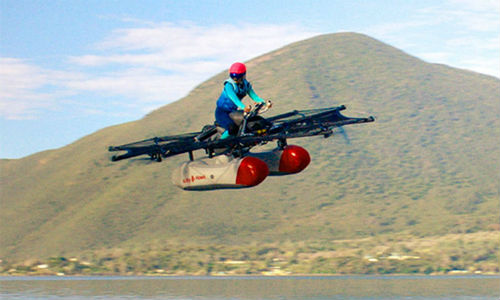By Jeff Sanford
– Last week the Canada Conference Board held the second annual Canadian conference on AVs. You can see some of Collision Repair magazine’s coverage of the session here and here. Barrie Kirk, President of the Canadian Automated Vehicle Centre of Excellence (CAVCOE) led a plenary session, “Beyond AVs: Personal Airborne Transportation.”
According to the description, “As if AVs were not disruptive enough, the next disruptive transportation is currently being developed and tested. Personal Airborne Transportation (PAT), or to use its more familiar term, flying cars, will be here soon.” According to Kirk, “It’s about 40 years since the Jetsons were on television and now it’s finally becoming fact.” He notes that a Chinese company will release the E-Hang 184 (one passenger, eight rotors, four arms) by the end of the year. “They got started making drones. But then they kept making drones bigger and bigger … and then they put a pod on top.” The vehicle is short range. It can carry a person up to 220 pounds and a smaller suitcase, and that’s all. “But this has been tested,” says Kirk.
Airbus has two programs working on airborne AVs. One will be a vehicle, the Air Bus, which will take passengers from an airport downtown. “Airbus has been looking at congestion in the world’s biggest cities. Tokyo has 40 million in one city. That’s bigger than the population of Canada. Congestion is going to be a fact of life,” says Kirk. A true PAT will be one where the passenger does not have to be a pilot. “You program in your destination and it takes you,” says Kirk. “There is a lot of room on condos and office buildings to put a landing area. The top of parking lots would make sense as well … The technology is moving very quickly. It’s moving much quicker that the ability of civil servants to regulate. We know that Dubai is moving quickly. E-Hang has been testing in the US.”
– According to a report earlier this week, Uber will kick off its very first “Elevate Summitt,” a three-day conference in Dallas, “on flying cars. According to the media report, “Last October, the company released a white paper that envisioned a flying taxi service as a network of lightweight, electric aircraft that take off and land vertically from preexisting urban heliports and skyscraper rooftops. A few months later, the company hired Mike Moore, the former chief technologist for on-demand mobility at NASA’s Langley Research Center and one of the leading thinkers on VTOL aviation … These VTOL (pronounced vee-toll) aircraft would operate using fixed wings with tilt prop-rotors. In other words, they would take off vertically like a helicopter, and then accelerate into forward flight using wing-borne lift … Most notably, Uber said it wasn’t going to build its own flying car, but stood ready to ‘contribute to the nascent but growing VTOL ecosystem and to start to play whatever role is most helpful to accelerate this industry’s development.’ That probably translates into, ‘Come to us with a decent prototype and we’ll buy it.’”
The article goes on to suggest that, considering the recent problems at Uber, the idea of this idea getting off the ground seems less likely than it did even a couple months ago.
– Another story in the tech media profiles a company, Otonomo, that just raised money through a stock offering and is already selling data collected from connected cars to third parties. According to the story, “Cars have only become connected to the internet in the last few years, but sensors to support autonomous driving capabilities and smart infotainment consoles are contributing to an influx of data that the auto industry has never seen before … Big Data is poised to grow even more as automakers pursue fully self-driving vehicles and the government prepares to mandate vehicle-to-vehicle communications, allowing future cars to talk with each other while driving.”
A McKinsey & Co. report suggests data could become a $750 billion industry by 2030. “Traditional car manufacturers will be joined by content/service providers, end-to-end mobility providers, infrastructure providers, and insurers in the competition for the connected customer as new services and business models will allow them to access customers in the car and target this new value pool,” according to the report. The company that just raised money from investors, Otonomo, is already using cloud technology to collect, organize and sell data to third parties. The startup says it works with nine major automakers and has a partnership with Mercedes’ parent company, Daimler.
“The startup has raised $40 million in total funding … More than 1 million cars on the road are already connected to the Otonomo platform, and that number will rise to 5 million by the end of 2017. The startup splits whatever it makes selling the data with the automaker that supplies it.” The report goes on to say that, currently, Otonomo “adheres to the Driver Privacy Act of 2015 that states all data collected by a vehicle is the property of the owner or lessee of that vehicle unless the owner gives explicit consent to share it. What drivers may not realize is that they have consented to hand over that data simply by agreeing to the terms and services of their infotainment consoles, like Daimler’s COMMAND or General Motors’ OnStar,” according to the report.
The McKinsey study included a survey that found, “Of the 3,184 respondents … 55 percent said they would allow it and 24 percent said they would not allow it under any circumstances. The other 21 percent said they would share data that helped improve the car’s product, under the condition it would not be sold to third parties.” According to the story, “… there may be instances where consumers want to share certain kinds of data, similar to how people use their smartphones today. For example, drivers may elect to share their location to get alerts about open parking spots nearby. Otonomo can monitor everything from tire pressure to battery life, meaning it can inform a driver they need to see a mechanic before a car breaks down. For self-driving cars, fleet managers could receive alerts if there’s problem and program the car to drive back to its home base for further evaluation.”
The story goes on to say that car manufacturers will need to provide visibility about what is being done with the data generated by connected cars.
– An article in the Shanghai Daily summarizes some of the interesting AV tech that showed up at that city’s auto show recently. The chairman of the “mobility solutions business sector” at Bosch, Rolf Bulander, was quoted in a story as saying that, “As the world’s largest automotive market, China is also an important market for automated driving technologies.”
The article goes on to note that “Bosch said it will cooperate with AutoNavi, Baidu and NavInfo—three leading high-definition map providers—in automated driving technology. The partners aim to jointly launch an accurate map service called ‘Bosch Road Signature’ for automated driving in China.” The service will combine high-definition maps with Bosch’s advanced camera and radar sensors to provide automated wayfaring. Some of the other AV highlights on display in Shanghai:
• “Valeo, a French auto parts maker, presented automated driving solutions by bringing two analysis and artificial intelligence systems at the show. The company hopes these systems will better serve the automated vehicle market and offer new mobility services in China.”
• “Continental, a German auto parts supplier, debuted globally its camera-cleaning system for automated driving vehicles. Cleaning dirt off camera lenses is important for automated vehicles which have to continuously acquire and interpret data of its surroundings to ensure safe driving, the company said,” according to the news story.
• “Adient, which separated from Johnson Controls last year, is developing seats with carmakers for autonomous vehicles in China. The company hopes the seats will be ready for production and be applied in vehicles by 2020,” according to the report. A spokesperson for the company was quoted as saying, that, “As automated driving technology advances, the interior design will become the focus for consumers. Interior features will be more important as people will spend more time in automated vehicles. It is not a driver-centric but a rider-centric driving experience for automated driving in the future.”





































